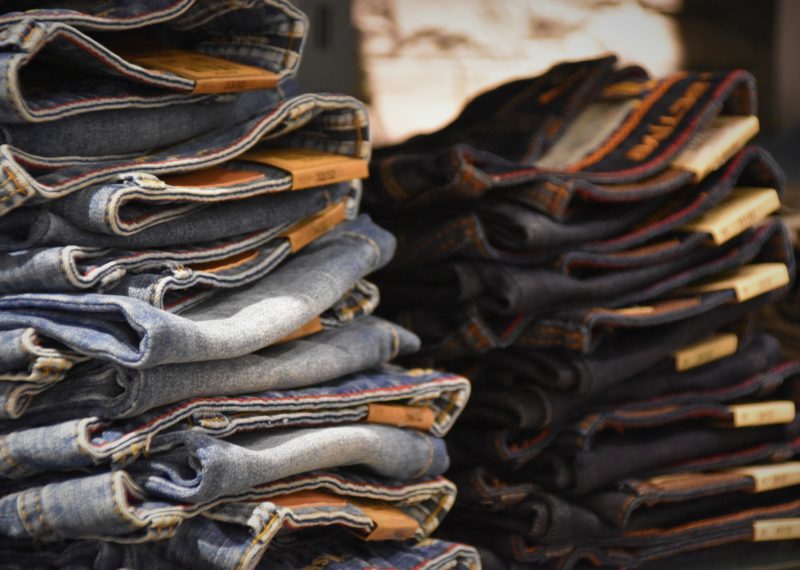To celebrate the 150th anniversary of its famous 501 jeans, Levi’s announced the release of a new plant-based 501 Jean.
If you’re slightly confused by this, you’re not alone. After all, a typical pair of 501s isn’t made of leather or any other animal product. It’s cotton. In fact, its label says, “100% cotton.”
But while that label is legally correct, it doesn’t tell the whole story.
“Today’s denim has very little in common with what people were making a couple of hundred years ago,” said Stefano Aldighieri, a California-based denim consultant who has worked with Levi’s and other denim brands. That rough-and-tumble, stiff cotton denim favored by railroad workers is long gone.
Today, a typical pair of jeans contains polyester thread, poly-cotton interior pockets, polyester zipper tape, plastic interfacing inside the waistband, polyester tags and labels, and, depending on the design, polyester and elastane added for stretch.. Almost all of these synthetics are derived from petroleum.
“Even when things are marked cotton, and we think we’re shopping for cotton products, we are still participating in a petrochemical economy,” said Paul Dillinger, Levi’s vice president of Global Product Innovation. He said that in a small pair of women’s jeans marked as 100% cotton, up to 10% comprises other materials. That’s because the Federal Trade Commission only requires manufacturers to list materials that comprise 5% or more of the product’s weight.
Plastics and petrochemicals are in almost everything we wear, cleverly disguised as polyester, nylon, elastane, acrylic, dyes, buttons, threads and performance finishes. Polyester dominates the fashion industry, making up about half of all fashion textiles today.
“I always give [my students] the image of going to fill up your car with gas, you squeeze the nozzle and imagine your Lululemon pants coming out,” said Kimberly Guthrie, associate professor of fashion design and merchandising at Virginia Commonwealth University. (Most of Lululemon’s popular pants, with branded fabric names like Nulu and Everlux, contain mostly nylon, polyester and elastane.) “They’re so shocked that it takes a while for it to click, and then they go through their clothes and they realize: oh my gosh, it’s all polyester.”
As a whole, the fashion industry accounts for between 2% and 4% of global carbon emissions — about as much as the combined emissions of France, Germany and the United Kingdom. And, according to a 2021 report by the World Resource Institute, about a quarter of the sector’s emissions come from “the cultivation and extraction of raw materials” — much of which is derived from fossil fuels. (More than half of the industry’s emissions come from processing, dying and manufacturing trims, according to the report.) Polyester production alone accounts for 98 million tons of CO2 emissions a year.
Getting polyester, nylon and synthetic dyes out of the supply chain –– along with swapping dirty technologies for renewable energy at factories and dye houses, and reducing shipping emissions — would go a long way toward reducing the fashion industry’s greenhouse gas emissions.
It also would help with the sector’s massive waste problem, which, in recent years, has become infamous for its contribution to piles of waste on the beaches of Ghana and the Atacama desert in Chile.
While cotton itself is very recyclable and biodegradable, once you add synthetic dyes and finishes, it’s unfit for the compost pile. Cotton recyclers have to cut off and dispose of the entire top and side seams of a pair of jeans so it doesn’t contaminate the chemical recycling process or jam up the mechanical recycling machines. Forget about recycling a pair of jeans made with 21% polyester –– even if that polyester is recycled from bottles.
Compared to the rest of the fashion industry, denim is relatively fossil-fuel-free. But as a basic and ubiquitous part of every person’s wardrobe, it’s a useful case study on how we got here, and what it would take to get fossil fuels out of our closets again.
How We Got to Fossil-Fuel Denim
There are two ways to tell this story. Levi’s Dillinger describes a slow slide as the industry blithely innovated. “Fossil fuel-derived materials have been added in subtle, small, discreet little areas for efficiency and performance over time,” he said.
Cotton thread was replaced with polyester thread, which was stronger and wouldn’t break when run through new, faster industrial sewing machines. Brands started pre-destroying jeans, giving them acid wash, tumbling them with pumice stones, abrading them with sandblasting, bleaching them, taking Dremels to them for holes –– and polyester thread could hold the seams together in those processes. Brands started adding stretch, and customers no longer had to lie down on the floor to button their flies. And regular folks also started treating their jeans differently, washing and tumble-drying them after almost every wear.
Because of the way we produce and care for our jeans, even these new Plant-Based 501s still have a bit of polyester thread in areas that need extra reinforcement.
But there’s another way to tell this story, and that is that capitalism got ahold of what was once a craft. “It was really because of productivity and margins; it had nothing to do with durability or any other reason,” Aldighieri said. Synthetics are cheaper, and according to Adighieri, allow for less skilled design. “If you’re making what has become a disposable product, you don’t really need to over-engineer it.”
Innovative Luddites
Many sustainable fashion advocates today want to return to a past of slow, artisanal fashion made with traditional materials. Where we buy things and keep them and repair them until they fall apart, and then we compost them.
But many are also developing more sustainable fabrics that could fit into our current, global fashion system.
Kathleen Rademan, the innovation platform director at the Amsterdam-based accelerator Fashion for Good, said big fashion brands are talking about and testing out ways to get petroleum out of their products. “A lot of them have commitments in their [corporate social responsibility] targets to a certain percentage of recycled content or to preferred fibers,” she said.
“Preferred fibers” tend to include organic cotton, Tencel (a man-made fiber from eucalyptus trees) and polyester made from recycled consumer plastic. But a new crop of so-called bio-based fibers use inputs like agricultural waste and microbes.
Recently, Guthrie and her students visited the micro-factory of the Candiani denim mill in Italy, where they learned about and took home the mill’s Coreva stretch biodegradable denim, made with plant-based rubber for elasticity. Candiani claims it will biodegrade in your backyard compost.
Levi’s new Plant-Based 501s, while seemingly a return to basics, represent years of research and development. The patch on the back is made of Mirum, a plant-based leather alternative. It’s dyed with plant-based indigo from Stony Creek Colors, whose capsules can be dropped right into modern dyehouse machinery.
These processes and materials don’t come cheap. Levi’s women’s plant-based jeans cost about $30 more than the regular 501s.
Aldighieri worries that at current production levels — by some estimates, the fashion industry produces over a billion jeans globally per year — growing enough indigo plants to replace the approximately 80,000 metric tons of synthetic indigo produced a year would take away farmland from food crops. A similar question has dogged bio-plastics.
But Dillinger pushes back against that narrative, pointing out that farmers growing indigo for Stony Creek Colors are switching away from tobacco, a non-necessary crop. And indigo is a good rotational crop for cotton, fixing nitrogen in the soil after cotton takes it out.
“Back-of-the-napkin math on how many acres it would take to harvest sufficient indigo to satisfy this company’s needs are not so outrageous that we couldn’t do it, it’s just going to take a lot of hand-holding and a lot of passion and commitment,” he said.
“To say that we can’t do it this way, so we’re gonna have to stick with pumping it out of the ground, that’s a difficult argument to make during the hottest year on record,” Dillinger added.
Plant-based jeans hit stores last month, and Dillinger said it’s too soon to tell how they’re resonating with shoppers. But he points to regulatory proposals in the EU around fast fashion that might make phasing out synthetic blends and trims mandatory.
“If we can prove that there’s appetite, if we can prove that there’s viability on the small scale, plus the potential regulatory mandate to make more products this way, I think it’s going to unlock a lot of possibilities.”
Nexus Media News is an editorially independent, nonprofit news service covering climate change. Follow us @NexusMediaNews.


